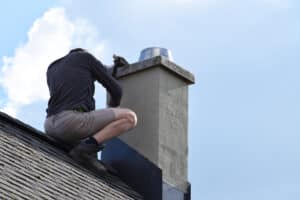
Your typical homeowner’s insurance policy will cover your roof replacement if it gets damaged by a covered peril, like sudden accidents or acts of nature. Problems from regular wear and tear, old age, or lack of maintenance are not eligible for reimbursement. Such damages are often categorized under the general maintenance responsibility of the homeowner.
Always review your insurance policy with your insurance agent to understand what is and isn’t covered. Most insurance providers offer limited coverage, if any, for residential roofs over 20 years old.
How Roof Replacement through Insurance Works
To ensure approval of your insurance claim, keep accurate records of repairs, before-and-after photos, and roof inspection reports. You also need to notify your insurance provider promptly when damage occurs to your roof.
If Mother Nature directly damages your roof or triggers other sorts of havoc—such as a violent windstorm toppling a tree onto your roof, your homeowner’s insurance should cover the cost of replacement. Generally, the claim process involves the following:
1. Call Your Roofing Contractor to Inspect the Damage
The first step is to call your roofer to thoroughly inspect the roof to determine the extent of damage and advice if a replacement is necessary. A reputable roofer will also have experience replacing roofs through insurance and will guide you through the claim process.
2. Call your Insurance Company and Begin the Claim Process
Next, call your insurance agent and begin the claim process. By the time the insurance adjuster arrives, your roofer would have helped you piece together all the necessary evidence of damage. This may include before and after pictures of your roof, previous inspection reports, and a detailed estimate on the cost of replacement.
3. Your Roofing Contractor and Insurance Adjustor Meet
It is always advisable to have your roofer on site when the insurance adjuster arrives. This way, they can compare notes and reach a fair settlement which will adequately cover the cost of replacement.
4. Insurance Approves the Claim and Work Begins
Once the insurance adjuster has completed their evaluation, they’ll either approve or deny the claim depending on the weight of the gathered evidence. But if you were up to date with regular maintenance and your roof was still well within its useful life, your claim should be approved without troubles. Usually, your insurer will issue the first check and the work will begin.
5. Pay the Contractor for their Work
The final step is to pay your roofing contractor the full amount for the work done. Some roofers will usually allow you enough time to get the final check from your insurer to settle the payment. However, you should note you’ll still need to pay your deductible before your insurance coverage kicks in.
The Bottom Line
To get the best chance of your insurance paying for your roof replacement project, be sure to call them promptly for an inspection. More importantly, work with an experienced roofer to gather up vital documents such as a copy of your insurance policy, roof inspection reports, before and after photos, and receipts for any repair or maintenance works done on the roof.
Also, age is not your roof’s friend. Unless you have a roofing system famed for longevity, like slate, your roof depreciates with each passing year. Most insurers won’t cover those which are over 20 years old, and improper maintenance or neglect may also result in claim denial. Here at Adam Vaillancourt Roofing, we have years of experience replacing roofs through insurance in the Southern New Hampshire and Northern Massachusetts area. Contact us today to schedule a free inspection or to learn more about insurance and roof replacement.




